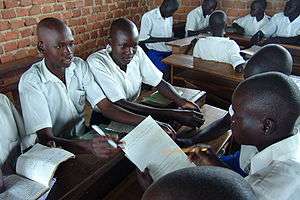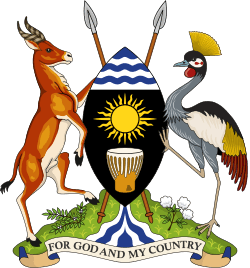Education in Uganda

The system of education in Uganda has a structure of 7 years of primary education, 6 years of secondary education (divided into 4 years of lower secondary and 2 years of upper secondary school), and 3 to 5 years of post-secondary education. The present system has existed since the early 1960s.
Primary education

In 1999 there were 6 million pupils receiving primary education, compared to only 2 million in 1986. Numbers received a boost in 1997 when free primary education was made available for four children per family. Only some of primary school graduates go on to take any form of secondary education. This is contingent upon them passing their Primary Leaving Examinations (PLE).
Uganda is one of East Africa's developing countries, bordered by Tanzania, Rwanda, the Democratic Republic of the Congo, South Sudan, and Kenya. It occupies 236,040 square kilometres (91,140 sq mi) and has 26,404,543 people. According to CIA World Fact Book 2004, more than 80 percent of its population is rural and 35 percent lives below poverty line (Ngaka 172). The United Nations characterized the current condition of Uganda with its unstable government and struggling people as "the world’s worst humanitarian crisis". (Moyi 6)
In 1997, the Ugandan government introduced the Universal Primary Education (UPE) program to improve enrollment and attainment in primary schools. It was initially realized to provide free education for four children per family, but the program was not performing based in its regulations due to the complex structure of Ugandan families. Most Ugandan families have more than four children and households started sending every child, which resulted in a rapid increase in student enrollment in primary schools (Ngaka 172). Due to the circumstances, President Museveni announced that the UPE was open to all children of all families (Omona 74). When the new policy was executed, schools experienced a massive influx of pupils and the demand for learning materials, teachers, and infrastructure became a challenge to the education system (Ngaka 172). Ngaka argues that the UPE resulted in costly consequences, including but not limited to a poor quality education, low pupil achievement, untrained teachers, improper infrastructures and classroom settings (173).
Uganda has seven years of primary education and the legal age for school entry is six (Moyi 3). According to the Ministry of Education and Sports (MoES) statistics, school enrollments increased from 3 million to 5.3 million in 1997 and the number rapidly increased to 7 million by 2004 (Kakura 137). Even though the increased number of pupils was perceived as a good thing, there were only 125,883 teachers, breaking the UPE required pupil-teacher ratio of 1:40 (Kakura 138). The large number of pupils makes the learning environment more difficult and it becomes harder for the teacher to be heard and teach. According to Arbeiter and Hartley, classes have between 70 and 150 pupils and there is over-age studying in all schools. Moyi explains the issue of many classes having the inappropriate age of pupils to be driven by the late enrollment or grade repetition, which in turn is caused by the poor quality of education (8). For instance, “third grade included pupils aged between seven to sixteen years and in sixth grade there were pupils up to nineteen years of age” (Moyi 66).
Secondary education
Uganda's secondary education system follows the education system of its former colonial masters, Britain. It is divided into the Ordinary level and Advanced level. Lower secondary consists of 4 years of schooling at the end of which students undertake Ordinary-level exams (O-level) in at least 8 subjects with a maximum of 10 subjects. Upper secondary consists of 2 years of schooling at the end of which students sit Advanced-level exams (A-level) in at least 3 subjects.
The curriculum for lower secondary is currently being reviewed by the National Curriculum Development Center, and a new curriculum is expected to be rolled out in 2014 or 2015.
Three-year technical schools provide an alternative to lower secondary school. Alternatives for graduates from lower secondary school include: 2-3 year Technical institutes; 2 year Primary Teacher Colleges (PTC); Department Training Colleges (DTCs) and Upper secondary schools; including:
- Kitante Hill Secondary School - Mixed day school
- St. Mary's College Kisubi - All boy's boarding school
- Mount Saint Mary's College Namagunga - All-girl boarding school (S1 to S6)
- Kibuli Secondary School - Mixed day and boarding school (S1 to S6)
- Bugema Adventist Secondary School - Mixed boarding school(S1 to S6)
- King's College Budo - Mixed boarding school (S1 to S6)
- Gayaza High School - All-girl boarding school (S1 to S6) - Oldest girls secondary school
- Uganda Martyrs' Secondary School Namugongo - One of the best in the country
- Mengo Senior School - Mixed day school
- Ntare School
- Nabumali High School
- St. Henry's College Kitovu
- Makerere College School
- Comboni College
- German Secondary School Uganda[1]
- Kiira College Butiki - Boys' boarding school in Jinja (S1 to S6) founded in 1959
- Ebony College Luwero - Mixed day and boarding school (S1 to S6)
- Seat of Wisdom Secondary School- All-girl day and boarding school (S1 to S6)[2]
- Sseguku Hill College- All-girl day and boarding school (S1 to S6)[3]
- Mackay Memorial College Mixed day and boarding school located in Nateete (S1 to S6)
- Serere Township Secondary School[4]- A Christian private "O" and "A" Level Mixed Day and Boarding School
International schools
- International School Of Uganda
- Rainbow International School
- Kampala International School
- Ambrosoli International School
- Heritage International School
- Acacia International School
- Galaxy International School Uganda
- Vienna College Namugongo
Post-secondary education
Although 60,000 to 70,000 students in Uganda leave secondary school each year qualified to go on to higher education, only some 35 per cent of them (at most 25,000) are able to find places at the limited number of institutions. The majority of students go to universities, both public and private. Makerere University in Kampala has about 95 percent of the total student population in Uganda's universities. The remainder are distributed among the more than 20 private universities and a smaller number of non-university institutions. Recognised universities in Uganda include:
Government universities
- Busitema University
- Gulu University
- Kabale University
- Kyambogo University
- Makerere University
- Mbarara University of Science & Technology
- Muni University
- Soroti University
Religious-affiliated universities
- All Saints University
- Ankole Western University
- Bishop Stuart University
- Bugema University
- Busoga University
- Islamic University in Uganda
- Kumi University
- LivingStone International UniversityLink
- Ndejje Christian University
- Uganda Christian University
- Uganda Martyrs University
- Uganda Pentecostal University
Private secular universities
- African Rural University
- Busoga University
- Cavendish University Uganda
- International Health Sciences University
- International University of East Africa
- Kabale University
- Kampala University
- Kampala International University
- Mountains of the Moon University
- Muteesa I Royal University
- Nkumba University
- St. Augustine International University
- St. Lawrence University
- Uganda Technology and Management University
Music schools
Northern Uganda
Education is important for a successful post-conflict transition in Northern Uganda (see Conflict in Northern Uganda), as it helps develop peoples' abilities to break free of circles of violence and suffering.[5] Uganda's Universal Primary Education (UPE) has resulted in high enrolment rates in Northern Uganda, but education tends to be of a low quality and few pupils actually complete primary school. There are inadequate facilities; e.g. out of 238 primary schools in Pader, 47 are still under trees, limited teacher accommodation is causing high rates of teacher absenteeism and in some areas the average primary school teacher to student ratio is 1:200.[5]
Furthermore, there is some evidence to suggest completion of secondary school is necessary to provide an individual with a proper chance to escape poverty, as employment and income levels for those who completed primary schools are similar to those who did not attend at all.[5] Their region has particular difficulties as teachers are hard to find, the conflict created a lost generation without an adequate education themselves and teachers from other areas are still highly concerned about security in the region.[5]
See also
References
- ↑ German Secondary School in Uganda
- ↑ http://www.graduates.com/ss/554017
- ↑ http://hellouganda.com/listing/listing.php?id=86 Archived July 25, 2014, at the Wayback Machine.
- ↑
- 1 2 3 4 Kate Bird and Kate Higgins (2009) Conflict, education and the intergenerational transmission of poverty in Northern Uganda London: Overseas Development Institute
- Ngaka, Willy. Co-Operative Learning In A Universal Primary Education System. International Journal Of Learning 13.8 (2006): 171-178. Education Research Complete. Web. 5 Mar. 2014.
- Moyi, Peter. Primary School Attendance and Completion Among Lower Secondary School Age Children in Uganda. Current Issues in Education 16. 2 (2013) : 1-16. Print.
- Kakuru, Doris M. "HIV/AIDS, Children's Rights And Gender Equality In Uganda's Universal Primary Education." International Journal Of Learning 14.2 (2007): 137-148. Education Research Complete. Web. 10 Mar. 2014.
- Omana, Julius. Organisational Culture: Uganda’s Inspectorate Department of Education. International Journal of Educational Administration. Vol 2, Number 1. 73-99. 2010. Print.
External links
- Education Statistics and Quality of Education in Uganda, Southern and Eastern Africa Consortium for Monitoring Educational Quality (SACMEQ)
- Ministry of Education and Sports, The Republic of Uganda,
- Education and Sports Sector Fact Sheet 2000 - 2012
